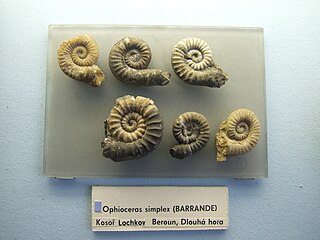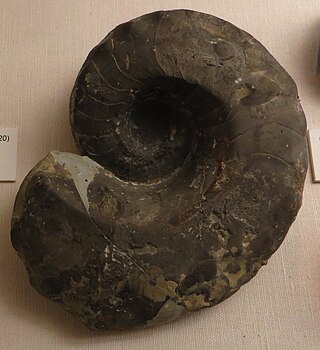
Trocholites is a tarphycerid genus in the family Trocholitidae from the Middle and Late Ordovician with a gradually expanding, weakly ribbed shell; whorls in contact, dorsum slightly impressed; cross section depressed, venter and sides rounded; siphuncle close to but not at the dorsal margin.

Discoceras is an extinct marine cephalopod mollusk, a member of the Trocholitidae in the Tarphycerida. It is distinct from Discosorus, It is characterized by closely coiled, gradually expanding shells with a subquadrate cross section, that may be ribbed or smooth. The sides are broadly rounded; the venter is wide and slightly rounded. The maximum width is slightly dorsal of the middle. The dorsum has a slight to moderate impression. The siphuncle starts off central for the first half whorl then becomes marginodorsal in the succeeding two whorls, then subdorsal at maturity. As with Trocholites, the dorsal siphuncle in Discoceras probably indicates an orientation during life that places the back of the living chamber high in the shell.

The Tarphycerida were the first of the coiled cephalopods, found in marine sediments from the Lower Ordovician to the Middle Devonian. Some, such as Aphetoceras and Estonioceras, are loosely coiled and gyroconic; others, such as Campbelloceras, Tarphyceras, and Trocholites, are tightly coiled, but evolute with all whorls showing. The body chamber of tarphycerids is typically long and tubular, as much as half the length of the containing whorl in most, greater than in the Silurian Ophidioceratidae. The Tarphycerida evolved from the elongated, compressed, exogastric Bassleroceratidae, probably Bassleroceras, around the end of the Gasconadian through forms like Aphetoceras. Close coiling developed rather quickly, and both gyroconic and evolute forms are found in the early middle Canadian.
Tarphyceras is a genus of tarphyceratid with whorls rounded in cross section, having a deeply impressed dorsum and a ventral to subcentral siphuncle, known from the Lower Ord of North America. It differs from Campbelloceras in that Campbelloceras is only slightly impressed, from Centrotarphyceras in that Centrotarphyceras is subquadrate and has a central siphuncle, and from Trocholites in that although Trocholites is subcircular in cross section, the siphuncle is subdorsal.
Curtoceras is a genus in the tarphycerid family Trocholitidae found widespread in the late Early and Middle Ordovician of North America and northern Europe. Curtoceras has a shell that is gradually expanded, with half the fully mature body chamber divergent from the preceding volution. Whorl sections are near equidimentional with the inner margin (dosum) moderately impressed. The surface may be smooth or weakly ribbed. The siphuncle is ventral in the initial chamber and becomes dorsal after one volution. With the exception of the dorsal siphuncle, Curtoceras is somewhat similar to the tarphyceratid Campbelloceras
The Tarphyceratidae are tightly coiled, evolute Tarphycerida with ventral siphuncles. The dorsum is characteristically impressed where the whorl presses against the venter of the previous. The Tarphyceratidae are derived from Bassleroceras or possibly from some member of the Estonioceratidae.

The Trigonoceratoidea are a superfamily within the Nautilida that ranged from the Devonian to the Triassic, thought to have contained the source for the Nautilaceae in which Nautilus is found.
The Tripteroceratidae is a family of depressed, straight to slightly curved nautiloid cephalopods from the middle and upper Ordovician with generally flattened venters and empty siphuncles with straight to inflated segments included in the Oncocerida.
Syringonautilidae is a family of Nautiloidea from the middle to late Triassic. Syringonautilidae comprise the last of the Trigonoceratoidea and are the source for the Nautilaceae which continued the Nautiloidea through the Mesozoic and into the Cenozoic right down to the recent. Syringonautilidae is a strictly Triassic family, derived early in the Triassic from the Grypoceratidae.

Grypoceratidae is the longest-lived family of the Trigonoceratoidea, or of the near equivalent Centroceratina; members of the Nautilida from the Upper Paleozoic and Triassic.
The Centroceratidae is the ancestral family of the Trigonoceratoidea and of the equivalent Centroceratina; extinct shelled cephalopods belonging to the order Nautilida
The Naedyceras group comprises three similar and closely related openly coiled, gyroconic, genera within oncocerid family, Brevicoceratidae: Naedyceras, Gonionaedyceras, and Gyronaedyceras.
Thuringionautilus is a genus of large, moderately involute, nautiloids from the nautilid family Tainoceratidae. The whorl section is subquadrate, flanks slightly convex, venter broad with a median furrow. Ventral shoulders, narrowly rounded to subangular; umbilical shoulders, broadly rounded. Longitudinal nodes slope diagonally backwards on the venter toward the furrow. Suture, slightly sinuous. Siphuncle, subdorsal.
Enoploceras is a Tainoceratid genus, a nautiloid cephalopod in the order Nautilida, known from Triassic sediments in Europe, India, Timor, and the state of Idaho.

Ophioceras is a genus of closely coiled tarphycerid nautiloid cephalopods, the sole representatives of the family Ophidioceratidae, characterized by an evolute shell with narrow, subrounded, annulated whorls and a subcentral siphuncle composed of thin connecting rings that show no evidence of layering. The mature body chamber is strongly divergent and is the longest proportionally of any tarphycerid. The aperture has a deep hyponomic sinus and ocular sinuses, and so resembles some lituitids.
Simardoceras is a genus in the discosorid family Westonoceratidae from the Middle Ordovician of Quebec.
Chidleyenoceras is a Middle Ordovician tarphyceroid with a closely coiled, evolute shell; whorl section subquadrate, widest just above a broadly rounded venter; dorsum with a broad shallow impression; sutures moderately spaced, weakly sinuous; siphuncle large, subventral, apparently orthochoantitic with tubular segments.

Alaskoceras is a genus of lower Ordovician coiled nautiloid cephalopods; the shell moderately expanded, ribbed, with a divergent living chamber; whorl section more broadly rounded ventrally than dorsally; siphuncle marginal at maturity, septal necks short, almost achoanitic; connecting rings thick, layered.

Germanonautilus is a cephalopod genus included in the nautilid family Tainoceratidae, found widespread in the Triassic of North America, Europe, Asia, and north Africa. The shell is a moderately involute nautilicone ; whorl section subquadrate to trapezoidal, widest across the umbilical shoulders, flanks flattened and ventrally convergent, venter flat and wide, dorsum narrowly and deeply impressed. The suture is with broad and deep lateral lobes and a shallow ventral lobe. The siphuncle is central and nummuloidal, composed of expanded segments that give a beaded appearance.

Domatoceras is a nautiloid genus and member of the Grypoceratidae from the Pennsylvanian and Permian with a wide spread distribution.







